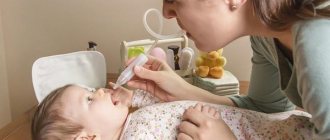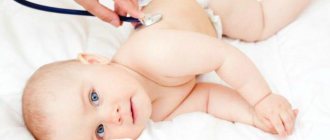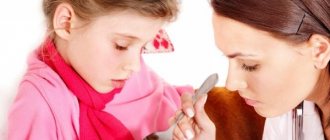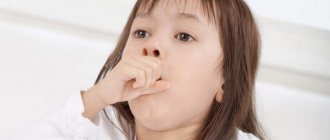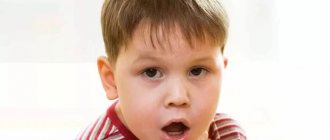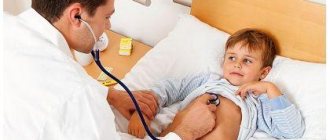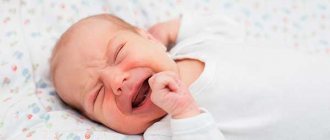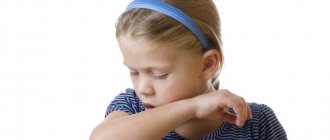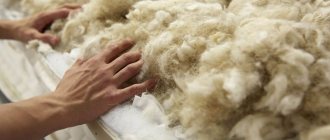Cough medicines for children
Parents should remember that there is no universal cough medicine. When prescribing drug therapy, the attending physician takes into account the possible causes of this phenomenon. Each remedy is used in specific circumstances and affects the child’s body in a certain way.
Sometimes medications are used to disable the cough center. Codeine is considered one of these drugs; it has a depressant effect and suppresses cough. Such medications are contraindicated for children because they belong to the narcotic group.
There are cough medications that have a non-narcotic effect, but require caution when taken and monitored by a doctor. Among them are known such as Sinekod, Tusuprex, Glaucine and others. They inhibit the cough reflex and weaken the signals coming from the affected mucous membrane in the bronchial tree. These medications are rarely prescribed to young children, only in exceptional cases.
Uncontrolled use of antitussives leads to serious consequences. With the help of cough, the bronchi and lungs are cleared of excess phlegm and harmful microorganisms. When this function is inhibited or disabled, the most favorable conditions are created for the occurrence and development of infection. In the presence of a wet cough, excess sputum, stagnating in the body, disrupts the ventilation function, causing bronchitis or pneumonia.
Coughing due to non-infectious respiratory pathologies
Bronchial asthma is characterized by severe swelling and narrowing of the respiratory gap. Breathing becomes difficult, the child cannot exhale, he pushes air out of himself with difficulty. Asthma is another cause of persistent cough. The attack has much in common with an allergic reaction, but in its course and treatment, bronchial asthma differs from allergies.
“Checking” is often associated with congenital or acquired pathology of the nasal septum. When they are bent, it is difficult for a child to breathe through his nose, especially after active games. The child suffocates, gasps for air, chokes on it and begins to cough.
Enlarged adenoids cause constant discomfort in the throat. The baby tries to cope with it with the help of “cackling” and coughing up the object that is bothering him. This cough is usually mild, intermittent, and accompanied by difficulty breathing.
Antitussives
There are two groups of cough medicines. The first group consists of sedatives used for dry coughs. With their help, irritation in the respiratory tract is reduced, which relieves coughing attacks. Another group includes expectorants, which dilute mucus during a wet cough and remove it from the respiratory tract.
The classification of antitussive drugs includes drugs of central, peripheral action and combination drugs. Additionally, these medications are divided into narcotic and non-narcotic. Children are prescribed non-narcotic medications that suppress cough and are not addictive.
A classic example is Sinekod. The central nervous system reacts to its effects, and the cough subsides immediately after taking it. Such symptomatic treatment normalizes the baby, relieves bronchial spasms and makes breathing easier. As a result of taking Sinecode in combination with other drugs, recovery occurs faster.
Non-drug therapy
There are a number of specific requirements and rules regarding the regime of a sick child and maintaining appropriate conditions in his room:
- Humidification of the atmosphere.
The mucous membrane of the respiratory tract in a healthy person should be moisturized. As soon as the humidity and temperature regime changes, the mucous membrane begins to dry out and it is easier for various viruses and microbes to parasitize on it. It is necessary to maintain moist air and create a cool temperature in the child's room.
To do this, the room is regularly ventilated 4-5 times a day and always before bedtime. As a humidifier, you can use special devices (humidifiers, air ionizers), a nebulizer with saline solution. In the absence of such devices, during the heating season, place plates with mineral or salt water under the radiator or start an aquarium.
- More liquid.
The production of mucus and phlegm occurs in special goblet cells. In order to enhance mucus production and make it more liquid, the child is asked to drink the maximum amount of liquid (water, juices, fruit drinks). In addition, drinking plenty of fluids helps to quickly remove bacterial breakdown products and toxins from the baby’s body, which significantly speeds up the treatment of cough.
- Good nutrition and food regimen.
A balanced diet during illness will allow the baby to receive all the necessary vitamins and microelements without accompanying dietary supplements and synthetic vitamins.
- Walks in the open air.
A child with a cough, runny nose and a low temperature of up to 37.5 degrees can and should go outside. A walk helps calm the baby, and fresh air has a beneficial effect on the mucous membranes of the respiratory tract and strengthens the natural immune defense.
It is important to understand these recommendations correctly. A sick child needs treatment, attention and rest. You shouldn’t take a baby with a high fever out for a walk, and you shouldn’t lock a coughing child at home within four walls for a week.
Mucolytics
The main purpose of mucolytic drugs is to thin the sputum. These medications differ in the content of ambroxol, acetylcysteine, bromhexine, carbocisteine, sobrerol and other similar substances. They are included in cough syrups intended for children.
These products are prohibited for use if the child has not reached the age of two. This is due to the weak development of the cough reflex during this period. Taking mucolytics dilutes sputum and increases its volume, which the baby cannot cope with. As a result, such treatment leads to severe respiratory complications. Therefore, in young children, treatment for a wet cough consists of rinsing the nose with saline, humidifying the room and drinking plenty of fluids.
The child “huffs” due to psychological problems (stress)
One of the reasons for coughing may be stress. When a baby is in a stressful environment, for example among unfamiliar adults, observes a conflict between parents, does not see his mother for a long time, he experiences a spasm of the respiratory muscles, which causes strange coughing sounds.
A nervous cough becomes a habit. As soon as the baby feels anxiety, worry, fear, he begins to cough. The pediatrician will not find pathologies of a physiological nature with a nervous cough. A child psychologist can help get rid of such coughing.
Expectorants
When you cough, the mucous membrane first becomes inflamed, and then sputum is formed. Depending on the presence or absence of sputum, the cough can be dry or wet. Therefore, coughing is important, with the help of which accumulated mucus is removed from the respiratory tract.
Expectorants are divided into two types. Secretolytic drugs dilute sputum and increase its quantity. Mucolytics also thin mucus and improve expectoration. For the treatment of children, the first option is more often used. Among these drugs, Flavamed should be noted, which has mucolytic, secretomotor and secretolytic effects. The therapeutic effect of the drug is provided by ambroxol hydrochloride, which is an active substance from the group of secretolytics. The sputum is liquefied by direct action on the secretion, leading to expectoration. As a result, a wet cough decreases, the inflammatory process in the bronchi decreases, and the conditions for the appearance and development of pathogenic microorganisms in the respiratory tract are eliminated.
Among the expectorant drugs, it should be noted: Gedelix, Mucaltin, Doctor Mom herbal syrup, Bromhexine, licorice root and others. The prescription of the medicine and dosage is made by the pediatrician after examining and examining the sick child.
Allergic cough
With allergies, the cough is dry and hacking. It is necessary to monitor in what cases it appears and identify the allergen. The most common allergens are plant pollen, animal hair, chemicals, dust, and clothing lint. If a baby starts coughing after smelling flowers, stroking a cat, or after a certain meal, then most likely this is an allergen.
To eliminate the “sniffing”, it is enough to remove the object that causes the allergic reaction. If allergies are caused by plant pollen or other common objects, then it is almost impossible to protect the child from contact with them. To prevent allergies from becoming fatal, you should contact an allergist-immunologist who will prescribe antihistamines.
Folk remedies for cough
Not only traditional medications are used to treat cough. There are many recipes in folk medicine that are no worse than drugs in terms of effectiveness.
A popular tincture based on honey and radish is used for wet coughs. A hole is cut into the radish into which one teaspoon of honey is placed. The mixture of radish juice and honey is infused for at least four hours. The finished product is consumed at intervals of three hours, 1 - 2 teaspoons.
Treatment is often carried out using banana decoction. To prepare, take bananas (2 pcs.), sugar (2 tablespoons) and water (150 g). The resulting mixture is boiled. The resulting product has an enveloping effect and promotes the removal of phlegm. The decoction is consumed after meals for 3-4 days. A mixture of honey and onion juice has an expectorant effect. To obtain the drug, honey in the amount of two teaspoons is added to the chopped onion. The resulting mixture is infused for at least three hours. The finished product is taken before meals. For young children, a single dose is 1 teaspoon, and for older children - 2 teaspoons.
Compresses
Coughing attacks exhaust children, force them to spend a lot of energy fighting the disease, and disrupt normal sleep. Among traditional therapy and folk remedies, cough compresses are popular. They come in hot and cold, oil and alcohol, water and dry.
The use of warm compresses is more common. Under their influence, blood circulation in the area of application increases, reducing the inflammatory process. Before preparing a vodka compress, vodka is heated to human body temperature. Then, gauze or cotton cloth is dipped into it, lightly wrung out and placed on the child’s chest or back. Wax paper or plastic film is placed on top. If the baby has already reached the age of two, then such a compress is placed on the throat. This procedure is contraindicated for diseases associated with the thyroid gland.
Honey compresses are good for coughs. To do this, honey is heated in a water bath. Cotton fabric is folded into several layers, spread with liquid honey and placed on both sides - on the chest and back. The top of the compress is wrapped with plastic film. Sometimes cabbage leaves are used instead of fabric. To get rid of a hysterical bronchial cough, apply compresses with badger or fat tail fat of lamb, which is preheated. The amount of heated fat is 2 teaspoons mixed with 2-3 drops of pure kerosene. The mixture is used to rub the baby's chest, back and legs.
The use of compresses must be agreed upon with the attending physician.
Inhalations
The principle of inhalation treatment is the effect of warm, moist steam in combination with medications on the mucous membrane of the respiratory tract. As a result, blood circulation improves, viscous sputum becomes thinner, and there is less discomfort in the throat.
Depending on the cough, different types of inhalations are performed. A dry cough is accompanied by inflammation in the walls of the respiratory organs. There is a constant proliferation of infectious agents that linger in the body. A cough removes phlegm along with the products of inflammation and tissue breakdown, and clears the bronchi of infection. Therefore, a dry cough needs to be converted into a wet form as soon as possible. Inhalations are used for this purpose.
These procedures are carried out using ambroxol, which has mucolytic and expectorant properties. It is mixed with saline and poured into the inhaler. Therapeutic vapors are inhaled through a mask. The solution in the form of tiny particles penetrates the walls of the bronchi and lingers on them, providing a therapeutic effect.
It is recommended to combat wet cough by steam inhalation. They warm and moisturize the mucous membrane. As a result, sputum discharge improves. To enhance the healing properties of steam, medicinal plants are used, such as coltsfoot, mint, chamomile, thyme and others. The herb in the amount of two tablespoons is steamed in two glasses of boiling water, after which it is used for inhalation. The solution remaining after the procedure is filtered and taken orally. The effect of inhalation is enhanced by adding several validol tablets to the decoction. This solution is not suitable for internal use.
Mineral or soda water is also used for inhalation procedures. In the initial stage of the disease, it is recommended to breathe over the potatoes. The effect is achieved by garlic and turpentine inhalations and also by oil inhalations with fir, eucalyptus and other types of oils.
Warming up
Warming procedures during coughing in children are carried out not only with the help of inhalations and compresses. When deciding how to cure a child’s cough, ointments and oils are also used. The ointment is applied to the back and chest, except for the heart area, as well as to the throat, wings of the nose and legs. The drug is rubbed in with light movements, after which the sick child is covered with a warm blanket. Warming up is performed at night before bedtime. If the warming agent burns too much, it is recommended to mix it with baby cream in the same proportion and only then apply it to the body.
Previous
Cough in a childSymptoms of whooping cough in a child
Next
Cough in a childTreatment of cough in children with folk remedies
When do you need a doctor?
Coughing is not always safe or healthy. Parents need to know the main signs that indicate that their baby needs medical attention in the near future.
Polina Kizino, pediatrician: “How do you know when it’s time to see a doctor or even need to call an ambulance? Let us highlight eight such “red flags”, the appearance of which should be an alarming signal.
- Expressed anxiety. If you notice that your child is so bothered by his cough that his behavior has changed and he has become excessively restless, call a doctor. By the way, if you yourself are overly worried, also show your child to a specialist: a calm mother is very important for the baby’s speedy recovery.
- Difficulty in inhaling and/or exhaling. This is no time for jokes: call an ambulance immediately.
- Forced position. If you notice that the child sits only in a certain position, and when it changes, he notices a deterioration, call an ambulance.
- Noises when inhaling or exhaling. If you think you are hearing strange sounds, take your child to the doctor. This may not be as dangerous as you thought, but, of course, normally the child should breathe without any extraneous noise.
- Hoarseness is a sign that your child should be seen by a doctor.
- A very obsessive and rough cough, causing obvious discomfort to the child, exhausting, and giving no rest, is a reason to definitely show the child to a specialist.
- Sudden persistent cough against the background of complete well-being in young children. In general, you need to be on guard with children, and sharp negative symptoms against the background of health should always make parents want to see a doctor.
- Deterioration of general condition due to ARVI. If before this the child seemed to be on the mend or was stable, and suddenly there is a sharp deterioration in health (with or without a cough), then it is necessary to urgently show the child to specialists.
Be healthy and take care of your children!
- share with your friends!
Experts: Polina Aleksandrovna Kizino
